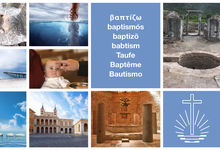The sacraments (58): Because corpses cannot eat
Vicarious baptism is a biblical pillar that supports the New Apostolic Church’s conception of salvation for the departed. An episcopal council is said to have forbidden it. This is how the story usually goes, but it is not quite correct. Here is the background and how it came to the decision.

So far we have discovered that the custom of vicarious (or proxy) baptism emerged in the first decades of Christianity. In some places, members of the churches had themselves baptised on behalf of the dead. Apostle Paul testifies of this in the first epistle to the Corinthians. And the Church Father Tertullian affirmed this in the second century.
Ambrosiaster’s commentary on the Pauline epistles from the fourth century also refers to vicarious baptism, according to which people in New Testament times “were baptised on behalf of the dead because they feared that someone who was not baptised would either not resurrect at all or only resurrect in order to be judged”.
Neither Paul nor Tertullian nor Ambrosisaster found fault with the motivation and practice of proxy baptism. But then it was forbidden.
A close look at the ban
“Baptism for the dead was banned by the sixth canon of the Council of Carthage in AD 397.” This or similar formulations usually end any debate on the matter. But this is only true when viewed superficially, at best.
What the regional council of North African bishops did decide was “that the Eucharist should not be given to the bodies of the dead” because “the Lord had said: ‘Take, eat,’ but the bodies of the dead can neither ‘take’ nor ‘eat’.” This was the reasoning behind the ban.
The question in Carthage in 397 was therefore not specifically about proxy baptism, namely the substitutionary act on the living for the dead. What was banned there, strictly speaking, was the dispensation of the Eucharist and baptism on corpses, on the bodies of the dead.
This was confirmed by the council of bishops in 419 at the same place with almost the same wording, when the bishops went through the decisions of their 15 previous meetings. But where did this idea of baptising corpses suddenly come from?
In the fight against heretics
“When a catechumen died, they would lay a living person under his bed; then they would ask the corpse if he wished to receive baptism, to which the living person under the bed would reply in the affirmative; then the living person would be baptised for the dead one.” The priest would then get down to work.
This is probably how things transpired among the Marcionites, a controversial form of early Christianity. At least that is what the Church Father John Chrysostom reports. The Bishops Epiphanius of Salamis and Philastrius of Brescia have similar stories to tell about the early Christian sectarian movements of the Cerinthians and the Montanists.
What these accounts have in common is that they all date from the fourth century. And they are part of the heresiographies, the combative theological writings against heretics. However, these do not necessarily mention baptism of the dead.
One of many controversial issues
The reason is rather an ongoing dispute between the heavyweights of church history on important theological issues. The debate had actually been started by the theologian and scholar Origen of Alexandria in the third century. The Church Father Augustine of Hippo put an end to debate, so to speak, in the fifth century.
One question led to another: Does the merciful God really want to punish people eternally, or will everyone be saved in the end after all? Can salvation only be attained in life or is it still possible in death? Did Christ only deliver the righteous from the old covenant when He descended into hell or did He also save sinners and Gentiles?
As so often, the camp of Augustine, to which Chrysostom also belonged, prevailed: according to them, God punishes eternally, salvation is possible only in this life, Jesus only helped the righteous, and the vicarious baptism of the dead should not take place.
Customs that endure
It was not easy to eradicate such customs. In the sixth century, Bishop Fulgentius of Ruspe, an eminent church author, felt compelled to write the treatise Mortui cur non baptizentur(Why the dead are not baptised).
“For unbaptised deceased or stillborn children, popular religiosity occasionally evaded this ban by miraculous and temporary resuscitations,” the renowned encyclopaedia Religion Past and Present states. This practice persisted “from the early church to modern times”.
The stillbirth of a child triggered a development in the still nascent New Apostolic Church. At the end of this development there were official sacraments for the dead. This will be discussed in the next part of this series.
Photo: vektorisiert - stock.adobe.com














